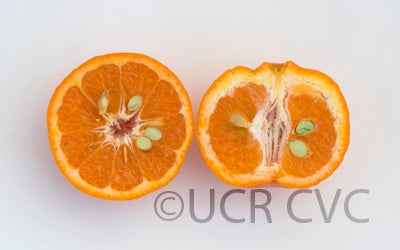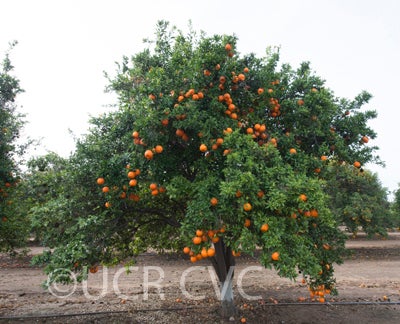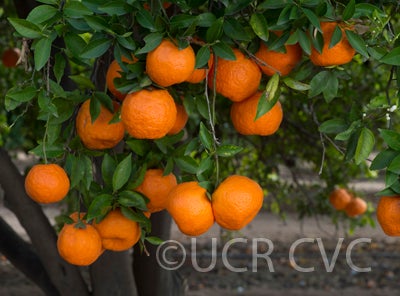Citrus reticulata Blanco
CRC 2893
PI 539496
VI 154
Source
The background and origin of 'Cravo' at Riverside is not well documented. The first reference in the cards is to budded trees planted in 1951, the bud source being in CRC 12. However, the VI record states that the source tree was a seedling planted in 1941 in CRC 11G. PI records show 4 introductions of 'Cravo': PI 36634, PI 38942, PI 166567, and PI 124174 (1937). The last was collected as seed by Dr Fawcett in 1937, and so seems the most likely source for a seedling tree planted in 1941. (RR Krueger, 08/17/2017)
Parentage/origins
Parents unknown.
Rootstocks of accession
Carrizo citrange, C-35 citrange
Season of ripeness at Riverside
Unknown at this time.
Notes and observations
RRK: Cravo' is described in Hodgson (1967, p 512-513) "Fruit medium to medium-large, slightly oblate or broadly obovate to subglobose, with moderately rough, rather loosely adherent rind of medium thickness and deep orange color. Segments about 10, loosely adherent; axis large and hollow. Flesh color deep orange; tender and melting; very juicy; flavor mold. Seeds few to medium in number and cotyledons light green. Very early maturity (in advance of Clementine). Retains quality exceptionally well when stored on tree and puffs very little.
"Tree vigorous and large, upright in growth habit, but spreading under weight of crop; typical broadly lanceolate mandarin leaves. Considerable tendency to alternate bearing with heavy crop of smaller fruit followed by smaller crop of larger fruit.
"The Cravo is grown principally in Sao Paulo State of Brazil, where currently it constitutes about 10 per cent of the acreage. The origin and history of this interesting variety are not known. While it may be of local origin, the possibility exists that it was introduced from Portugal, since the descriptions of Cravo and Carvalhais correspond fairly well."
Rodriguez and Viegas (1980, p 261-262) describe 'Cravo':
"Origin: The origin and history of this important variety are not known. While it could be of local origin, there is also the possibility that it was introduced from Portugal, since descriptions of Cravo and Carvalhais, the latter a Portugese variety, are very close. In Brazil, Cravo is cultivated principally in the State of Sao Paulo.
"Characteristics: Tree medium size, typically shaped with lanceolate leaves, typical of tangerines. Production very good, reaching on average 100 - 150 kg of fruit per plant. As with mandarins in general, it possesses a tendency to alternate bear, which can be eliminated in part with fruit thinning and adquate nutrition.
"The fruits have a flattened form, with about 20 - 22 seeds and an average weight of 135g; the skin has a color of strong orange, with average thickness and prominent oil glands. The pulp is a quite strong orange color, with a loose texture. It has abundant juice, 48 % of the fruit weight, with brix 10.8 %, acid 0.8 %, and ratio of 13.5. The fruits are destined for the internal market for natural consumption and also for the juice concentrate industry. It accounts for 11 % of the tangerine group, considering the number of plants existing.
"Recommendations: The cultivar presents early maturing fruit, extending from March to May. Included in the principal rootstocks for this cultivar are Orlando tangelo, Cleopatra mandarin, Rangpur, and Sunki."
Fruit is only about 1/2 colored with most fruits still greenish, but flavor is sweet, refreshing, somewhat bland. (EM Nauer, 11/23/1988)
Availability
Commercially available in California through the Citrus Clonal Protection Program. Click here to order budwood.
USDA Germplasm Resources Information Network page for Laranja Cravo mandarin




